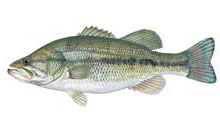Freshwater Fish - Species
Species Specific Regulations
Largemouth bass
Freshwater Fishing License required
Largemouth bass (Micropterus salmoides) - Native
Description: (Anatomy of a Fish)
The upper jaw extends back past the rear margin of the eye. Dorsal fin is deeply notched and the two sections of the fin are nearly separated. The upper body is dark green to olive while the lower body and belly are white. It has a series of dark blotches that merge into a dark lateral band. Largemouth bass usually have no teeth on the tongue.
Range: Statewide in all warmwater habitats
Average Length: 4 - 25 inches
Average Size: 1-3 pounds, eight-pound individuals are not uncommon
South Carolina State Record: 16 pounds 2 ounces (1949)
Life Expectancy: Approximately 23 years
Preferred Habitat
Largemouth bass can be found in slow-moving streams, pools of large rivers, natural lakes and all sizes of man-made impoundments.
Largemouth bass prefer warm, moderately clear water that has no appreciable current.
Food Habits
- Newly-hatched bass feed on zooplankton, switching first to insects and then to larval and juvenile fish as they grow.
- Adult largemouth bass primarily consume other fish. In a large impoundment, the major prey species include threadfin and gizzard shad, while in small impoundments sunfish will predominate in the diet.
- Basically, the largemouth bass will consume any organism that opportunity allows.
Spawning
- Spawning usually begins when water temperatures range between 65 - 75°F, around April to June.
- The male largemouth bass constructs a saucer-shaped nest at a depth of 2 to 10 feet. One or more females will deposit 5,000 to 150,000 eggs over the nest while the male fertilizes them.
- The eggs are guarded and fanned by the male until they hatch in 3 to 4 days. The male continues to guard the fry until they disperse several weeks after hatching.
Miscellaneous
The largemouth bass is one of the most important freshwater sport fish in South Carolina. More time and money are spent in the pursuit of this fish by anglers than any other species. In addition to being an important sport fish, the largemouth bass is an important part of the ecological balance of fish populations. In farm ponds where they are stocked with bluegill and redear sunfish, the largemouth bass are responsible for controlling the bream population through predation. In large impoundments, they serve a similar but different function in preying on shad populations. The largemouth bass is the dominant predator in many of South Carolina's fish populations.
Commonly Mistaken Species
Some species of fish that are commonly mistaken for this species:
Literature Cited
Rohde, Fred C, Arndt, Rudolf G., Foltz, Jeffery W., Quattro, Joseph M. 2009. Freshwater Fishes of South Carolina. University of South Carolina Press, Columbia, South Carolina.
Wildlife and Freshwater Fisheries Division. 2009. South Carolina Guide to Freshwater Fishes.
Fish Illustration by Duane Raver.


